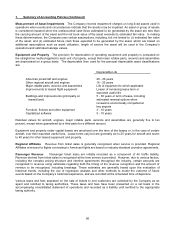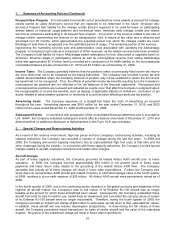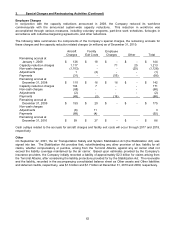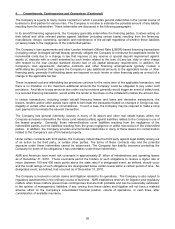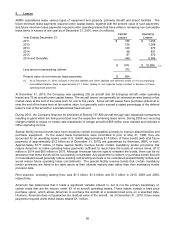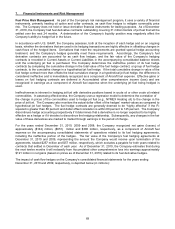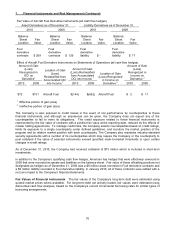American Airlines 2010 Annual Report Download - page 64
Download and view the complete annual report
Please find page 64 of the 2010 American Airlines annual report below. You can navigate through the pages in the report by either clicking on the pages listed below, or by using the keyword search tool below to find specific information within the annual report.
61
1. Summary of Accounting Policies (Continued)
Frequent Flyer Program The estimated incremental cost of providing free travel awards is accrued for mileage
credits earned by using American’s service that are expected to be redeemed in the future. American also
accrues a frequent flyer liability for the mileage credits that are expected to be used for travel on participating
airlines based on historical usage patterns and contractual rates. American sells mileage credits and related
services to companies participating in its frequent flyer program. The portion of the revenue related to the sale of
mileage credits, representing the revenue for air transportation sold, is valued at fair value and is deferred and
amortized over 28 months, which approximates the expected period over which the mileage credits are used.
Breakage of sold miles is recognized over the estimated period of usage. The remaining portion of the revenue,
representing the marketing services sold and administrative costs associated with operating the AAdvantage
program, is recognized upon sale as a component of Other revenues, as the related services have been provided.
The Company’s total liability for future AAdvantage award redemptions for free, discounted or upgraded travel on
American, American Eagle or participating airlines as well as unrecognized revenue from selling AAdvantage
miles was approximately $1.4 billion (and is recorded as a component of Air traffic liability on the accompanying
consolidated balance sheets) at December 31, 2010 and $1.5 billion as of December 31, 2009.
Income Taxes The Company generally believes that the positions taken on previously filed income tax returns
are more likely than not to be sustained by the taxing authorities. The Company has recorded income tax and
related interest liabilities where the Company believes its position may not be sustained or where the full income
tax benefit will not be recognized. Thus, the effects of potential income tax benefits resulting from the Company’s
unrecognized tax positions are not reflected in the tax balances of the financial statements. Recognized and
unrecognized tax positions are reviewed and adjusted as events occur that affect the Company’s judgment about
the recognizability of income tax benefits, such as lapsing of applicable statutes of limitations, conclusion of tax
audits, release of administrative guidance, or rendering of a court decision affecting a particular tax position.
Advertising Costs The Company expenses on a straight-line basis the costs of advertising as incurred
throughout the year. Advertising expense was $165 million for the year ended December 31, 2010, and $153
million for the years ended December 31, 2009 and December 31, 2008.
Subsequent Events In connection with preparation of the consolidated financial statements and in accordance
U.S. GAAP, the Company evaluated subsequent events after the balance sheet date of December 31, 2010 and
determined that no additional disclosure to that presented in this Form 10-K was necessary.
2. Special Charges and Restructuring Activities
As a result of the revenue environment, high fuel prices and the Company’s restructuring activities, including its
capacity reductions, the Company has recorded a number of charges during the last few years. In 2008 and
2009, the Company announced capacity reductions due to unprecedented high fuel costs at that time and the
other challenges facing the industry. In connection with these capacity reductions, the Company incurred special
charges related to aircraft, employee reductions and certain other charges.
Aircraft Charges
As part of these capacity reductions, the Company grounded its leased Airbus A300 aircraft prior to lease
expiration. In 2009, the Company incurred approximately $94 million in net present value of future lease
payments and lease return costs related to the grounding of the leased Airbus A300 fleet. The Company
estimates that virtually all of these charges will result in future cash expenditures. Further, the Company also
wrote down its owned Airbus A300 aircraft and related inventory to estimated salvage value in the fourth quarter
of 2009, resulting in a non-cash expense of $20 million. All Airbus A300 aircraft were permanently retired as of
2009.
In the fourth quarter of 2009, due to the continuing severe downturn in the global economy and weakness in the
regional jet aircraft market, the Company’s plan to sell certain of its Embraer RJ-135 aircraft was no longer
feasible at the amount for which these aircraft had been valued. Consequently, the Company reclassified these
aircraft from held for sale to held for use, tested them for impairment and concluded the carrying values of certain
of its Embraer RJ-135 aircraft were no longer recoverable. Therefore, during the fourth quarter of 2009, the
Company recorded an impairment charge of $42 million to write these aircraft down to their estimated fair values.
In addition, these aircraft will now resume depreciation prospectively. In determining the fair values of these
aircraft, the Company considered recent transactions for sales of similar aircraft and the value of the underlying
engines. No portion of the impairment charge will result in future cash expenditures.











